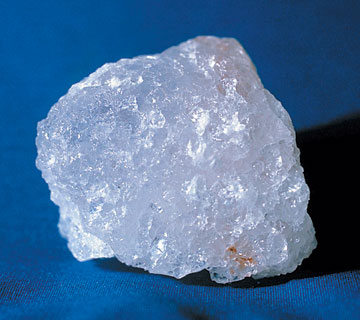
History
Salt also known as table salt or rock salt (halite), is a crystalline mineral that is composed primarily of sodium chloride (NaCl), a chemical compound belonging to the larger class of ionic salts. It is absolutely essential for animal life, but can be harmful to animals and plants in excess. Salt is one of the oldest, most ubiquitous food seasonings and salting is an important method of food preservation. The taste of salt (saltiness) is one of the basic human tastes.
Salt for human consumption is produced in different forms: unrefined salt (such as sea salt), refined salt (table salt), and iodized salt. It is a crystalline solid, white, pale pink or light gray in color, normally obtained from sea water or rock deposits. Edible rock salts may be slightly grayish in color because of mineral content.
Because of its importance to survival, salt has often been considered a valuable commodity during human history. However, as salt consumption has increased during modern times, scientists have become aware of the health risks associated with high salt intake, including high blood pressure in sensitive individuals. Therefore, some health authorities have recommended limitations of dietary sodium, although others state the risk is minimal for typical western diet.
-------------------
While people have used canning and artificial refrigeration to preserve food for the last hundred years or so, salt has been the best-known food preservative, especially for meat, for many thousands of years. A very ancient saltworks operation has been discovered at the Poiana Slatinei archaeological site next to a salt spring in Lunca, Neamţ County, Romania. Evidence indicates that Neolithic people of the Precucuteni Culture were boiling the salt-laden spring water through the process of briquetage to extract the salt as far back as 6050 BC. The salt extracted from this operation may have had a direct correlation to the rapid growth of this society's population soon after its initial production began.[3] The harvest of salt from the surface of Xiechi Lake near Yuncheng in Shanxi, China dates back to at least 6000 BC, making it one of the oldest verifiable saltworks.
Salt was included among funeral offerings found in ancient Egyptian tombs from the third millennium BC, as were salted birds and salt fish. From about 2800 BC, the Egyptians began exporting salt fish to the Phoenicians in return for Lebanon cedar, glass, and the dye Tyrian purple; the Phoenicians traded Egyptian salt fish and salt from North Africathroughout their Mediterranean trade empire.
In Africa, the Tuareg have traditionally maintained routes across the Sahara especially for the transportation of salt by Azalai (salt caravans). In 1960, the caravans still carried some 15,000 tons of salt a year but this trade has now declined to roughly a third of that figure.
Salzburg, Hallstatt, and Hallein lie within 17 kilometers (11 mi) of each other on the river Salzach in central Austria in an area with extensive salt deposits. Salzach literally means "salt water" and Salzburg "salt city", both taking their names from the German word Salzmeaning salt. The equivalent Celtic word was Hall, and Hallstatt was the site of the world's first salt mine.[6] The town gave its name to the Hallstatt culture that began mining for salt in the area in about 800 BC. Around 400 BC, the townsfolk, who had previously used pickaxes and shovels, began open pan salt making. During the first millennium BC, Celtic communities grew rich trading salt and salted meat to Ancient Greece and Ancient Romein exchange for wine and other luxuries. The word salary originates from Latin: salarium which referred to the money paid to the Roman Army's soldiers for the purchase of salt. The word salad literally means "salted", and comes from the ancient Roman practice of salting leaf vegetables.
In 1930, Mahatma Gandhi led at least 100,000 people on the "Dandi March" or "Salt Satyagraha", in which protesters made their own salt from the sea, which was illegal under British rule, as it avoided paying the "salt tax". This civil disobedience inspired millions of common people, and elevated the Indian independence movement from an elitist struggle to a national struggle.
Religion
In the Hebrew Bible, thirty-five verses mention salt, one of which being the story of Lot's wife, who was turned into a pillar of salt when she looked back at the cities of Sodom and Gomorrah (Genesis 19:26) as they were destroyed. When the judge Abimelech destroyed the city of Shechem, he is said to have "sown salt on it," probably as a curse on anyone who would re-inhabit it (Judges 9:45). The Book of Job contains the first mention of salt as a condiment. "Can that which is unsavoury be eaten without salt? or is there any taste in the white of an egg?"
(Job 6:6)
In the Christian New Testament, six verses mention salt. In the Sermon on the Mount,Jesus referred to his followers as the "salt of the earth". The apostle Paul also encouraged Christians to "let your conversation be always full of grace, seasoned with salt"
(Colossians 4:6).
Wikipedia